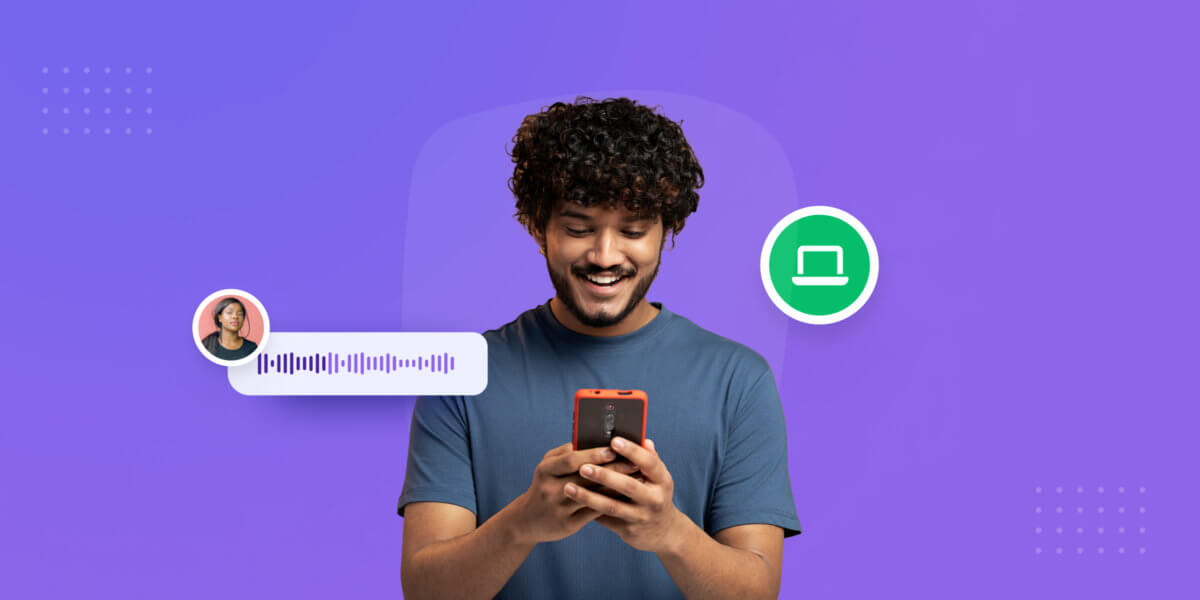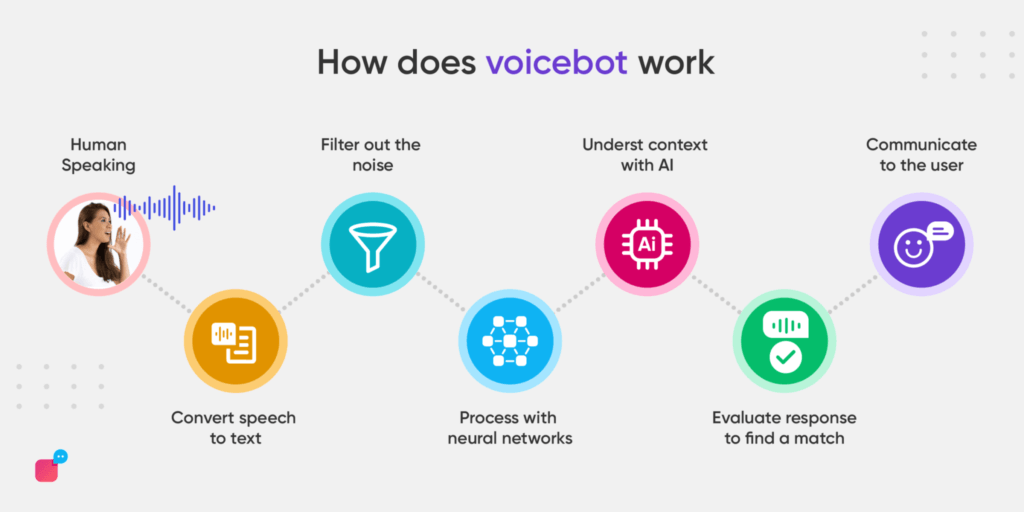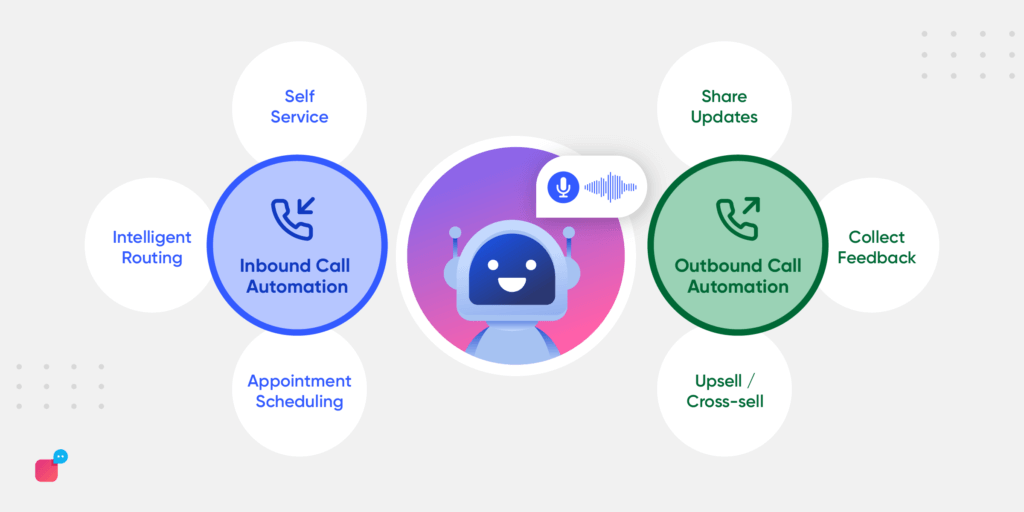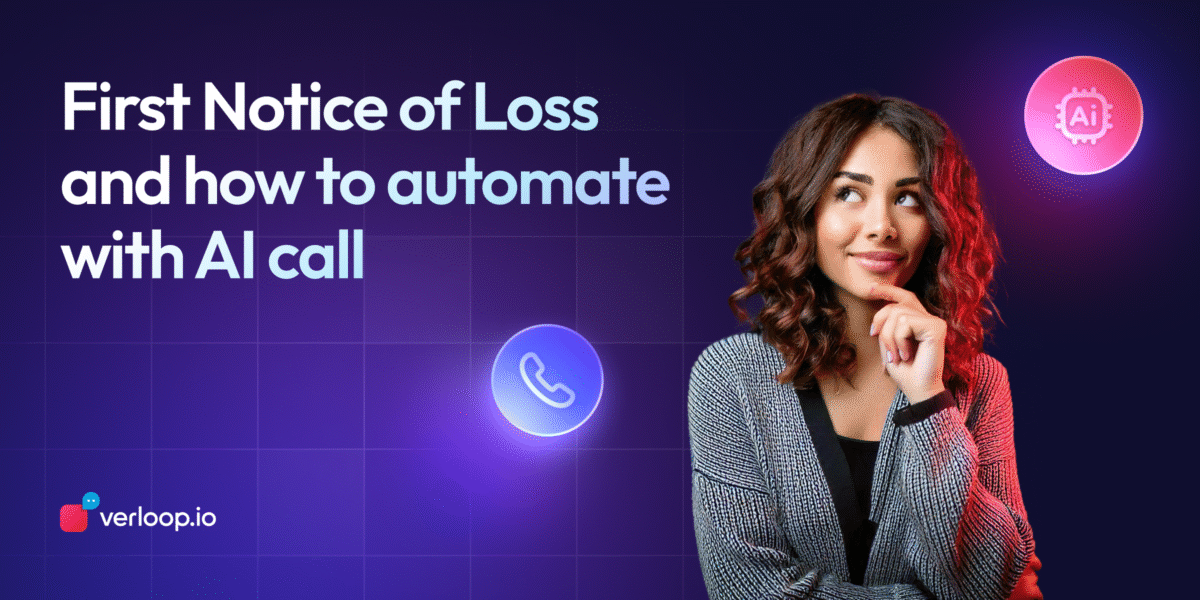
How Voice AI Call Solutions are Changing the Way We Interact?
- March 19th, 2025 / 15 Mins read
-
 Aarti Nair
Aarti Nair
Once considered as fiction, “talking” to machines is now a reality, thanks to the creation of the voice bot. Powered by AI, voice bots are software that enables users to communicate with machines with the help of natural human language. They allow speakers to navigate various aspects of business communication, like customer service, business calls or scheduling tasks. As an upgrade to IVR systems, Gen AI voicebots can automate inbound calls and outbound calls or connect customers to human agents.
New to voicebots? We’ve got you covered.
What is an AI voicebot?
By definition, an AI Voicebot is a conversational software powered by generative AI which understands, interprets, and analyses the message given by the customer in natural human language.
It is designed to automate and solve customer queries in real time by responding to them in audio form.
Voicebots can be rule-based, similar to IVR. Recently, voicebots refer to the conversational AI-powered bots that use NLP and ML to understand users’ intent, match the intent with the right answer and respond to users in human-like conversations.
Voicebots are extensively used in call centres to automate repetitive queries and help in reducing redundant tasks on agents. For example, if a customer calls to block a credit card, the voicebot can guide the user through the next steps without involving a human agent.
How AI voicebots work?
Voice bots use artificial intelligence and natural language understanding (NLU) to interpret, decode, and understand the intent and meaning in speech. Some voice bots powered with state-of-the-art language models like LaMDA or GPT-4V can even understand the context of human speech and respond in kind. This overarching technology is what we call Conversational IVR.

They employ input voice recognition and translation to understand the user’s queries or commands. This is then converted into text, which can be internal or visible to the user. The AI sifts through its database to formulate an appropriate response. Finally, a text-to-speech engine transforms the textual response into audio output, delivering the desired result.
What can AI voicebots do?
Voicebots integrated into different industries have provided innovative products and enhanced user experience.
- Smart Home Devices Usage: A report shows that more than 50% of U.S. adults own smart home devices with a significant percentage using voice assistants for these intelligent appliances. Voicebots power up such devices to make them work as per user commands.
- Customer Service: In customer support, voice bots enhance customer experience. They work 24/7 and create personal interactions with customers while handling multiple inquiries simultaneously.
- Generational Adoption: Voicebots are highly popular among the younger generations. For instance, 57% of teenagers in the US use voice search atleast once a day.
- E-commerce and Retail: Voicebots are revolutionising the retail and e-commerce shopping experience by assisting customers in finding merchandise, order tracking, or giving them personalised advice regarding products.
Use Cases: Where are AI voicebots used?
Contact centres come with their own challenges and voicebots help in mitigating them by reducing workload, and operating costs, and offering fast, efficient and autonomous service to the customers.
The voicebot use cases can be broadly classified into Inbound and Outbound automation. In this section of the article, we will learn about these two categories and what kind of activities can be automated with a voice bot.

1. Inbound Call Automation
Inbound calls are initiated by customers and a business responds to them reactively. These calls are generally regarding tech support, sales enquiries, complaints, appointments, etc. Needless to say, 80% of inbound calls are repetitive and frequently asked questions.
Automating inbound calls helps in reducing the load on the call centre, allowing businesses to serve more customers efficiently. It also cuts down initial wait times or busy signals for the customers, leading to more satisfied customers.
a. Self-Service
Self-service is a method where users access resources to find solutions on their own. It gives them the freedom of getting answers at a time convenient to them and the satisfaction of solving their issues on their own.
Eventually, this works in the favour of brands since self-service helps to save agents’ time as well, remove repetitive tickets and make customer support efficient.
Voicebot is a good medium to avail self-service as customers get accurate answers to FAQs and they can do that round the clock with 24x7x365 days availability.
b. Intelligent Routing
Intelligent routing (or skills-based routing) is a technology that connects users to the right agent so that the query is resolved in a timely manner. It overcomes the challenge of transferring the user’s call from one department to another, leading to bad CX.
Do you know 68% of customers get annoyed when their call is transferred between departments?
AI-powered voicebots come with intelligent routing that checks the agent’s skills, language proficiency, department and other such factors before assigning a call to them.
c. Schedule Appointments
Booking meetings and scheduling appointments are tasks that can easily be automated by giving users the right options. It’s also the tasks that take up a lot of the agent’s bandwidth.
Industries like healthcare or insurance use this for seamless customer engagement. For example: if a patient wants to book a follow-up appointment with a doctor, the voicebot can check the doctor’s calendar and patient’s history to find the best possible options and suggest accordingly. Or in the case of insurance, customers can schedule visits for vehicle inspection.
2. Outbound Call Automation
Calls initiated by businesses are called outbound calls and are proactive in nature. These calls are generally regarding updates on users’ orders, upcoming events, offers, and user feedback.
Outbound call automation works out well for businesses as more than two-thirds of customers want an organisation to reach out and engage with proactive customer notifications.
Brands can now use automated outbound campaigns with voicebots to reach more clients and free up human agents. Some common voicebot use cases in outbound call automation include the following.
a. Share Updates
Voice bots can provide real-time updates to customers about their orders, applications, appointments, etc. These calls keep customers informed and remove the urgency from a user to connect with an agent (indirectly reducing the load on call centres).
These outbound calls can be about order status, upcoming events, exclusive offers, trigger-based communication etc. By sharing such information, businesses can keep customers engaged and improve retention rates.
b. Collect Feedback
Collecting customer feedback or customer satisfaction (CSAT) score is paramount to getting insights into what your users think about your product or service. This information helps you align your goals to customer expectations.
But customers hate filling out forms. And that’s where voicebots come in handy. Voice bots can leverage the power of NLP to converse with customers using natural speech and collect answers to closed-ended questions, making the task easy and simple for both parties involved.
c. Upsell/ Cross Sell:
Up-selling and cross-selling are two powerful ways to provide value to your customers and also boost your revenues. AI can identify opportunities from your customer base where you can upsell or cross-sell your products and services.
Voice bots analyse the intent of customers using NLP and ML (machine learning) technologies and suggest relevant products to the users. As the cases are very user specific depending on the product they have purchased, their past shopping experience, and renewal date for subscription-type services, the experience is highly personalised and hence higher chances of conversion.
Read about more voicebot use cases: Top 10 Voicebot Use Cases to Improve Call Centre Experience
How are industries using voicebot?
There is no doubt that a voice bot can increase the quality of service of a business. We’ll look at the top 5 industry-wise use cases of AI voice bots in this section.
1. Banking
Banking and financial services around the world have started using voice bots to interact with customers and automate banking services. Those days are gone when customers needed to visit the bank for every small service. The effort was time-consuming and inefficient.
Now, it is easier with voice bots to afford banking services from the comfort of home. Voice AI also helps banks in operating different tasks, such as
- Outbound calls to remind customers about their payments and dues
- Kickstart loan application process
- Block stolen and lost credit or debit cards
- Authenticate users and do online KYC
- Enable seamless transactions and payments
- Automate customer support for repetitive queries
- Send alert for emergency or suspicious activities
2. Healthcare
Voice bots are earning their place in the day-to-day operation of the healthcare industry. It is more efficient and smarter in automating routine inquiries, sending reminders and connecting to patients to the right departments quickly.
Some common examples of voicebot use cases in healthcare include
- Book appointments with hospitals and clinics
- Collect customer information for first-time patients
- Spread awareness and useful health tips for prevalent diseases
- Remind patients about daily habits, check-in and follow-ups
- Locate nearby speciality hospitals and clinics
3. eCommerce
For scaling businesses, eCommerce needs a tool that can help them with prompt service and a voice bot helps e-commerce to do the same. When it comes to customer support, the quickest way to resolve the query of a customer is through speech.
With automated scripts and workflows, voice bots can satisfy customers with the correct solution within minutes. This will reduce cart abandonment.
eCommerce voicebot use cases include:
- Automate customer support for quick and 24×7 service
- Recommend products based on cart items
- Remind customers about items left in the cart
- Support customers through the purchase process
- Share updates on upcoming offers and campaigns
4. Insurance
Using a voice bot in the insurance industry is a great way to communicate with the customers in real-time without any human agent. Voicebots can help in sharing details about policy features, reminding customers about renewals and guiding users through claim processes.
Below we list a few voice bot use cases in insurance companies:
- Guide users in selecting policies and filling out forms
- Send timely reminders about upcoming renewals and new policies
- Share updates about customer’s policies
- Follow up on incomplete transactions
- Collect feedback on services
- Perform eKYC for customers
- Guide users through the claims process
5. Travel and tourism
Travel businesses are using voice bots for ticket booking, hotel reservation, navigation and much more. Accessibility and convenience of information in real-time are essential for every traveller these days.
With a voice bot, travel agencies can boost customer engagement and increase sales. Some common voicebot use cases include
- Provide customer support by being available and consistent at all times of the day
- Enable users to book, reschedule or cancel flights, hotels, etc.
- Recommend things to do to customers for better CX
- Connect users to live agents according to their time zones and location
- Inform customers about changes in flight schedules, hotel reservations etc.
Case Studies and success stories
One of the biggest success stories, that stands, of voice bots is Amazon’s Alexa. With Amazon’s market capitalisation of $1.57T by February 2022 and the estimated rise in voice e-commerce, it seems that Alexa will be going strong for the foreseeable future.
In India, several business ventures are using voice bots for key processes. For instance, ITC, which is one of the largest conglomerates in the country, has introduced voice bots in their subsidiary unit of Asian Tobacco Company Limited (ATC). It can easily understand and respond to queries in multiple complex languages like English, Hindi, Kannada, Tamil, and Telugu. It has helped them reduce their machine downtime by more than 30% and increase operational efficiency.
Benefits of using voicebots
Some of the most significant benefits of voicebots include:
1. Convenience and Hands-Free Interaction
A PWC research conducted on 1000 Americans in 2018 showcased that 90% of them used a voice assistant for various tasks.
It means users often rely on voice bots to manage devices and workflows or access information without the need for any manual input. Another benefit here is the hands-free experience which enables multitasking.
2. Personalised and Natural Communication
84% of companies already believe that chatbots will become more important for communication between a business and its customers. This focuses on another benefit of voicebots, which is to engage in natural language conversations.
3. Increased Efficiency and productivity
As per an Outgrow report, 57% of businesses state that chatbot usage results in improved ROI with minimal investments. The same applies to voice bots that help streamline tasks for users. It means the latter can focus on other priority tasks while the voice assistants help them with the minimal ones.
4. 24/7 Availability
13% of customers believe that every customer service department should answer all their calls instantly. Voicebots provide near-immediate solutions for customers with 24/7 cover and no wait times.
This is regardless of their location or time zone. It proves to be beneficial for those businesses that have global clientele and customers.
Subscribe to Verloop.io’s Newsletter for more information and tips on chatbot practices for your business.
Challenges and considerations
While voice bots are here to revolutionise the customer service experience but may not be ready yet to take over completely. The main difficulty challenge is the need for voicebots to expect users to repeat or rephrase their sentences or communicate more clearly than usual.
Other challenges include difficulty in comprehending complex requests and failure to grasp different accents. For a complex conversation, the voicebots might need human assistance. They also demand extensive training and support to deliver a seamless experience to the user. For example, voice bots might find it difficult to interpret the voice of a child.
These problems are also reflected in a survey conducted by Episerver that enquired with online shoppers from Western countries about voice bot usage. The results showed that the usage had dropped from 22% to 8% within a year.
The future of voicebots
The advantages of voicebots far outweigh their limitations. Machine Learning and Natural Language Processing are training voice bots to deliver results that mimic human interactions. As a result, users can expect more natural conversations with voicebots, enhancing their satisfaction level.
A report called “Voicebots Market Report – Forecast (2022-2027)” predicts the voicebot market to hold a share of USD 98.2 billion by the year 2027. This share is expected to come from usage in smart home devices with built-in speech recognition technology and the spread of smart speakers and smartphones.
Book a demo with Verloop.io right now to get a free trial!.







